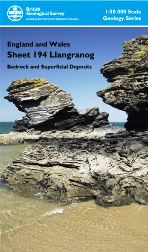Geology of the Llangranog District
1:50,000 Map Sheet 194 and Explanation

J R Davies, T H Sheppard, R A Waters & D Wilson
Published by: BGS
Publication date: 2006
ISBN: 075183448-3 (map) and 978-085272566-5
List price: £18.00 for the pack
38 pp (booklet)
www.bgs.ac.uk
This map supersedes the one-inch maps by pioneer geologists including Aveline, de la Beche, Phillips and Ramsay, published between 1845 and 1857. So, a 150-year interval, but better late than never!
The map is one of several long-awaited sheets covering central and northern Wales, most of which have been produced recently by the excellent BGS team listed above (who wrote the handbook) as well as others who helped in the mapping. The solid geology ranges only from the late Ordovician (Ashgill) to the early Silurian (Llandovery) and consists almost entirely of deeper-water sediments, mainly turbidites, filling the subsiding Welsh basin. There is a notable absence of igneous rocks. The monotony was only broken during the latest Ordovician (Hirnantian) ice age, when the 500m thick Yr Allt Formation was deposited, which includes some spectacular slumped sandstones, including giant sandstone pillows that are well exposed on rather inaccessible coastal cliffs. Afterwards the monotony returned, but the area includes the southernmost parts of the classic Aberystwyth Grits turbidites in the region near Newquay. Inland, the solid rock exposure is rather poor, since the area was blanketed during the Pleistocene (chiefly Late Devensian) glaciations, when Irish Sea and Welsh ice sheets combined to cover the region, depositing glacial and fluvio-glacial sediments with pebbles from across a wide area. The economic importance of the district (apart from aquifers) lies in a single road aggregate quarry.
So, in summary, not one of the most exciting parts of the geology of Britain, which probably accounts for the prolonged lack of attention; but nevertheless BGS must be congratulated on achieving its usual very high standard of mapping. The accompanying booklet is sadly rather short, presumably reflecting the lack of economic interest, and is no substitute for the traditional Survey Memoir; but it is certainly better than nothing.
Robin Cocks
Department of Palaeontology
Natural History Museum